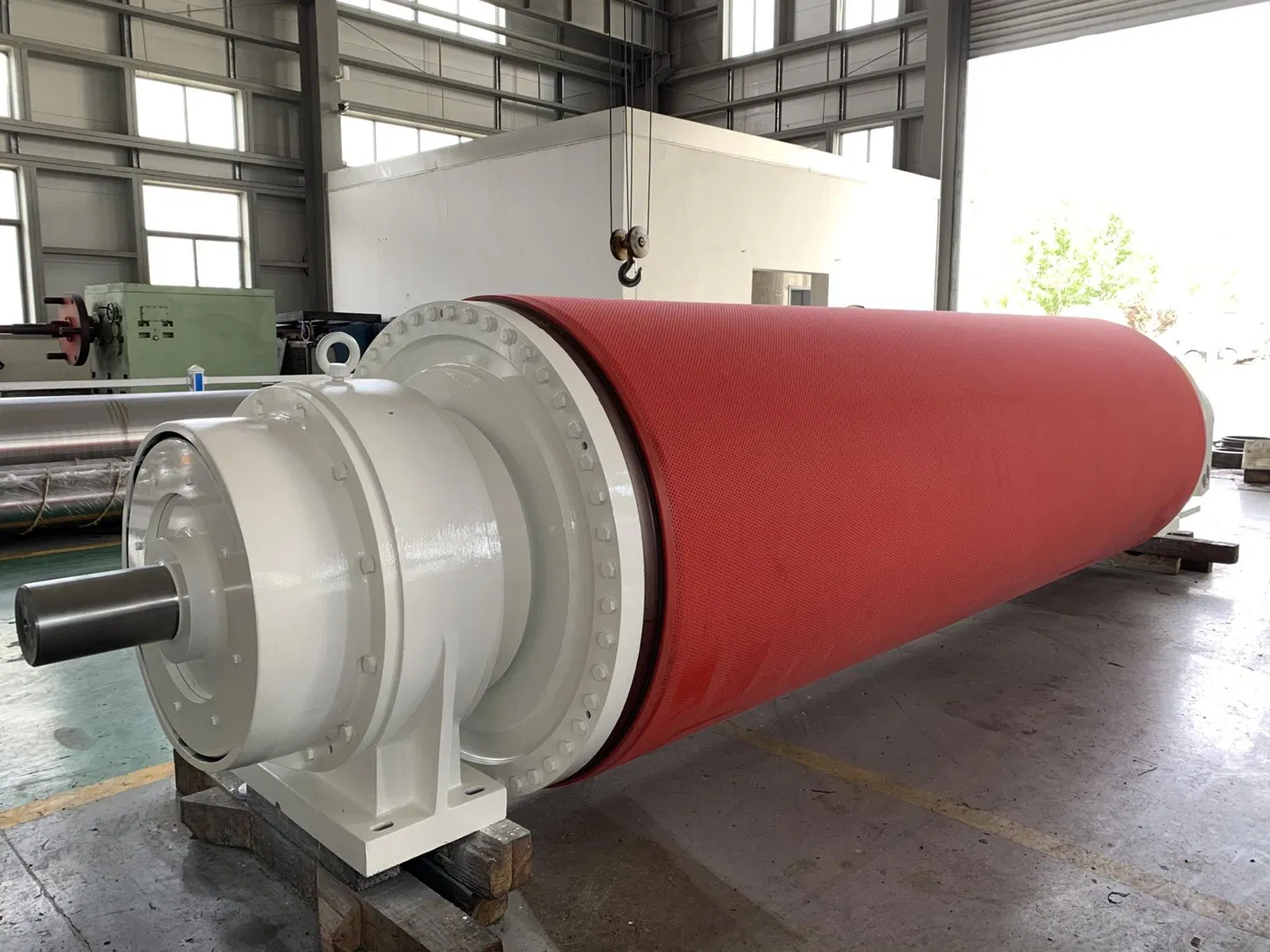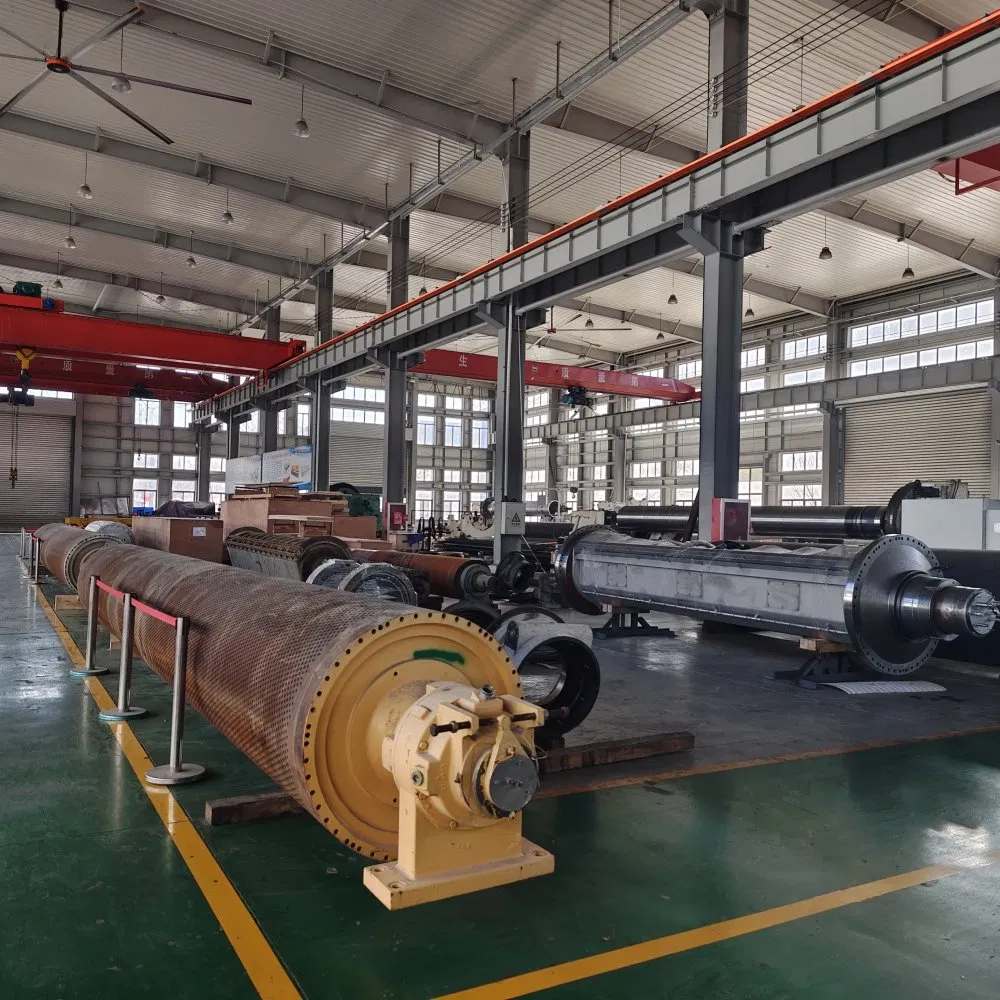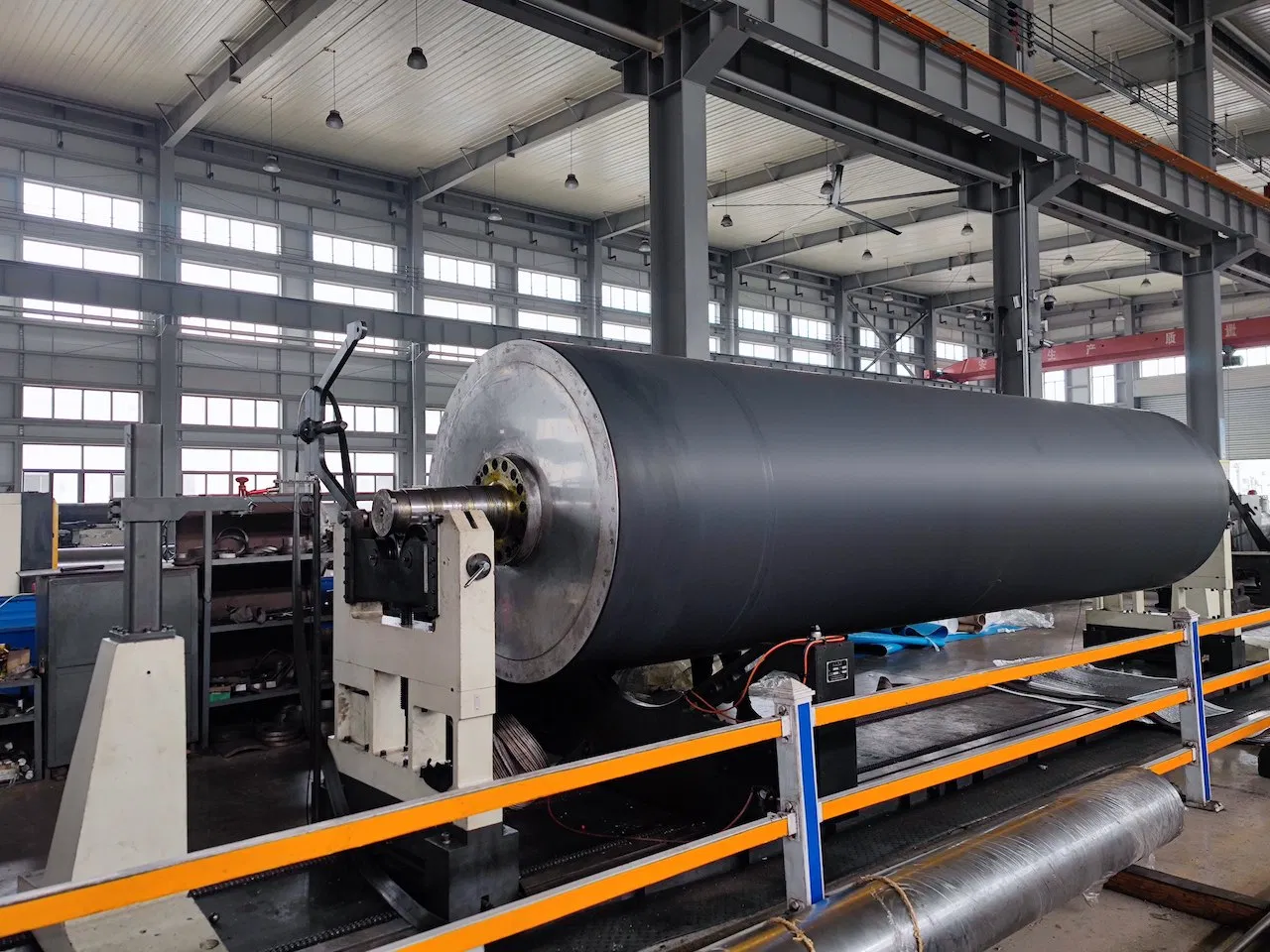What Exactly is a Blind Hole Press Roll?
Before diving into the factory operations, let's understand the star of the show: the blind hole press roll. In papermaking, after the paper pulp is formed into a web, it still contains a significant amount of water. The press section of the paper machine is where mechanical dewatering occurs, significantly reducing the water content before the energy-intensive drying section. Press rolls apply immense pressure to squeeze water out of the paper web and into accompanying felts. A blind hole press roll distinguishes itself with its unique surface design. Instead of a smooth or grooved surface, it features thousands of precisely drilled holes that do not go all the way through the roll's shell – hence "blind holes." These holes serve a crucial purpose: they provide voids for the water to escape into as the paper web is pressed, preventing the water from being reabsorbed by the paper (rewetting) and ensuring efficient water removal. The design of these holes – their diameter, depth, and pattern – is meticulously calculated to optimize dewatering for specific paper grades and machine speeds. Materials for these rolls typically include high-grade steel cores, often covered with specialized rubber or composite materials chosen for their resilience, chemical resistance, and ability to withstand extreme pressures and temperatures.The Critical Role in Papermaking Efficiency
The efficiency of dewatering directly impacts the overall energy consumption of a paper mill. Every percentage point of water removed mechanically in the press section translates to substantial energy savings in the dryer section, which relies on thermal energy. Therefore, a high-performing blind hole press roll is not just about making paper; it's about making paper more sustainably and cost-effectively. These rolls also play a vital role in determining the final quality of the paper, influencing properties like strength, smoothness, and caliper. Precision manufacturing by a dedicated blind hole press roll factory ensures that these rolls perform optimally, contributing significantly to a mill's bottom line and product quality.The Meticulous Process within a Blind Hole Press Roll Factory
The creation of a blind hole press roll is an intricate dance between advanced engineering, material science, and precision machining. It's a multi-stage process that demands unwavering attention to detail at every step. From initial design to final testing, every aspect is geared towards producing a roll that can withstand the harsh, demanding environment of a paper machine for years.Design and Engineering
The journey begins in the design office. Here, engineers use sophisticated CAD/CAM software to design the roll based on the client's specific requirements, machine parameters, and desired paper properties. This involves determining the optimal roll dimensions, material composition, and, critically, the precise pattern, depth, and diameter of the blind holes. Simulations are often run to predict performance under various operating conditions. Many modern blind hole press roll factory operations specialize in creating custom blind drilled rolls, tailoring every aspect to the unique needs of a particular paper machine.Core Fabrication and Drilling
Once the design is finalized, the core of the roll is fabricated. This usually involves casting or forging high-strength steel or other alloys, followed by initial machining to achieve the rough dimensions. The most defining step, however, is the drilling of the blind holes. This is performed using highly specialized, multi-axis CNC drilling machines. These machines are capable of drilling thousands of holes with incredible accuracy, ensuring consistent depth and spacing across the entire surface of the roll. The precision here is paramount; even slight deviations can lead to uneven dewatering, roll imbalance, or premature wear.
Covering and Finishing
After drilling, the roll typically undergoes a covering process. Depending on the application, a layer of rubber, polyurethane, or a composite material is applied to the roll's surface. This cover provides the necessary grip, wear resistance, and chemical stability. The application process is critical, ensuring uniform thickness and adhesion. Frankly speaking, this stage demands immense precision to prevent air pockets or inconsistencies that could compromise the roll's integrity. Following the covering, the roll is precisely ground to its final dimensions and surface finish. This grinding ensures perfect concentricity and a smooth, consistent surface profile. Finally, the roll undergoes dynamic balancing to eliminate any vibrations during high-speed operation, which is crucial for both paper quality and machine longevity.Advantages and Applications: Why Blind Hole Rolls Reign Supreme
The widespread adoption of blind hole press rolls in the paper industry isn't accidental. Their unique design offers several compelling advantages that contribute directly to improved operational efficiency and product quality. Understanding these benefits helps to appreciate the value proposition offered by a specialized blind hole press roll factory.Enhanced Dewatering Capabilities
The primary advantage of blind hole rolls is their superior dewatering efficiency. The blind holes act as temporary reservoirs for the expelled water, preventing it from being squeezed back into the paper web as the pressure is released. This means more water is removed mechanically, leading to a drier web entering the dryer section. This directly translates to significant energy savings, as evaporating water is far more energy-intensive than mechanically removing it. Furthermore, the even distribution of pressure and water removal helps to prevent crushing of the paper web, which can lead to quality defects. Many experts agree that efficient dewatering solutions are the cornerstone of modern paper production, and blind hole rolls are at the forefront.Versatility Across Paper Grades
Blind hole press rolls are incredibly versatile and can be found in paper machines producing a wide array of paper grades, from lightweight tissue and newsprint to heavy-duty linerboard and specialty papers. The ability of a blind hole press roll factory to customize hole patterns, cover materials, and roll dimensions allows them to tailor solutions for different pulp types, machine speeds, and desired paper properties. This adaptability makes them an indispensable component across the entire spectrum of paper manufacturing.Longevity and Maintenance
Given the harsh operating conditions, the durability and ease of maintenance of press rolls are crucial. High-quality blind hole rolls, manufactured with precision and robust materials, are designed for long service lives. Regular maintenance, such as grinding and re-covering, can further extend their operational lifespan, providing a strong return on investment for paper mills. The precise engineering minimizes wear on felts and other machine components, reducing overall maintenance costs and downtime.Quality Control and Innovation at the Forefront
In an industry where precision and reliability are paramount, quality control is not just a department; it's a philosophy embedded in every stage of a blind hole press roll factory's operations. The performance of a press roll directly impacts a paper mill's productivity and product quality, making rigorous testing and continuous innovation non-negotiable.Rigorous Testing Regimes
From the moment raw materials enter the factory to the final shipment of a finished roll, a comprehensive suite of tests ensures adherence to the highest standards. This includes: * Material Analysis: Verifying the chemical composition and mechanical properties of the steel core and cover materials. * Dimensional Checks: Meticulous measurement of every dimension, including diameter, length, and concentricity, to ensure it matches design specifications. * Hole Pattern Verification: Advanced optical and laser scanning systems are used to confirm the accuracy of every single blind hole's position, depth, and diameter. * Hardness Testing: Ensuring the cover material possesses the correct hardness for optimal performance and wear resistance. * Non-Destructive Testing (NDT): Techniques like ultrasonic testing and eddy current testing are employed to detect any internal flaws or defects in the roll core or cover that are not visible to the naked eye. * Dynamic Balancing: Perhaps one of the most critical tests, dynamic balancing ensures the roll operates smoothly at high speeds without vibrations, which could otherwise lead to uneven pressing, paper breaks, and damage to the paper machine.
Embracing Technological Advancements
The world of industrial manufacturing is constantly evolving, and leading blind hole press roll factories are at the forefront of adopting new technologies. Interestingly enough, this includes integrating smart manufacturing principles, leveraging IoT (Internet of Things) for real-time monitoring of production processes, and utilizing advanced robotics for precision tasks. Research and development are ongoing to explore new composite materials for roll covers that offer enhanced wear resistance, improved dewatering properties, and longer service life. Predictive maintenance technologies are also being developed, allowing mills to monitor roll performance in real-time and schedule maintenance proactively, minimizing unexpected downtime. This commitment to innovation ensures that the industry continues to push the boundaries of efficiency and sustainability.Choosing the Right Blind Hole Press Roll Factory: A Critical Decision
For a paper mill, selecting the right blind hole press roll factory is a strategic decision that can significantly impact operational efficiency, paper quality, and long-term profitability. It's not just about purchasing a component; it's about forging a partnership with a supplier who understands the nuances of your specific production needs. What truly sets a top-tier factory apart in your opinion?Experience and Expertise
Look for a factory with a proven track record and extensive experience in paper machine press roll manufacturing. Their expertise should extend beyond just making rolls to understanding the entire papermaking process, allowing them to offer insightful solutions and troubleshooting support. A factory that has successfully served a diverse range of clients and machine types is often a good indicator of their capabilities.Customization and Technical Support
Every paper machine is unique, and the ability of a factory to provide customized solutions is paramount. This includes tailoring roll dimensions, hole patterns, and cover materials to perfectly match your specific requirements. Beyond the initial purchase, assess the level of technical support offered. Do they provide installation guidance, maintenance recommendations, and quick response times for service inquiries? A strong commitment to after-sales support is a hallmark of a reliable partner.Reputation and Client Testimonials
A factory's reputation within the industry speaks volumes. Seek out testimonials, case studies, and references from other paper mills. A factory known for its consistent quality, on-time delivery, and excellent customer service is likely to be a trustworthy partner. Visiting the factory, if possible, can also provide valuable insights into their operational standards and commitment to quality.
The Future Landscape of Press Roll Manufacturing
The paper industry is continuously evolving, driven by demands for higher efficiency, sustainability, and quality. The blind hole press roll factory is at the forefront of this evolution, constantly innovating to meet these challenges. We can expect to see further advancements in materials science, leading to even more durable and efficient roll covers. Automation and artificial intelligence will likely play an even greater role in the manufacturing process, enhancing precision and reducing production times. Furthermore, the focus on energy efficiency and environmental impact will drive the development of rolls that contribute even more significantly to sustainable papermaking. In my experience, the future looks bright for this specialized field. The intricate engineering and relentless pursuit of perfection within these factories ensure that paper mills worldwide can continue to produce the essential products we rely on daily, with ever-increasing efficiency and environmental responsibility. The blind hole press roll, though often unseen, remains a critical component, and the factories that produce them are true unsung heroes of modern industry.For more detailed information, please visit our official website:blind hole press roll factory
About the author: Dr. Evelyn Reed is a seasoned expert in industrial machinery and pulp & paper technology, with over 20 years of experience optimizing manufacturing processes. Holding a Ph.D. in Mechanical Engineering, she specializes in the design and application of high-performance components for heavy industry. Dr. Reed frequently consults for leading paper mills and machinery manufacturers, sharing her deep insights into improving efficiency and product quality.


